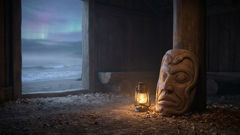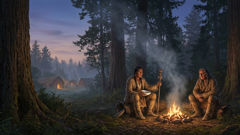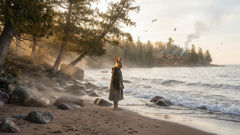Introduction
At the seam where rain-slick cedar forests meet the cold pulse of the sea, people have long watched for sign and shadow. The Sisiutl arrives in that borderland as a rumor at first—an upwelling in the glassy tide, a double ripple like two breathers sharing one body—then as a story told by elders at potlatches, carved into masks and bentwood boxes, and sewn into the edges of ceremonial regalia. In Kwakiutl and neighbouring coastal traditions this two-headed sea serpent embodies a braided set of meanings: danger and protection, transformation and power. Its twin heads mean that it both watches and mirrors; its eyes are said to hold a petrifying force so thorough that those who meet its gaze become stone. Yet the tale of the Sisiutl is not merely a terror story; it is a web of relationships—between sea and land, human and animal, maker and made—designed to teach respect, restraint, and a knowledge of the limits of human daring. The Pacific Northwest coastline, thick with fog and the tang of kelp, becomes a stage where cedar canoes, eagles, and orcas move through currents watched by a creature older than many houses. As tides rise and fall, so do the fortunes of those who honor or offend the rules encoded in song and carving. Here is a retelling that travels from origin to encounter, from ritual to modern remembering, following the Sisiutl as both fearsome being and enduring symbol of the living world’s mutual claims.
Origin and Shape: The Sisiutl as Living Parable
The Sisiutl's beginnings are told in many tongues along the coast, and each telling folds local color into a larger pattern. In one common form, the creature is born of sea and storm: a great coil of shadow and scale birthed where lightning meets the open water, its two heads forming like twin moons joined on a single sky. In another version it grows from a jealous union of sibling spirits—two temperaments that refused to be separated—so the Sisiutl carries the memory of kinship in its double face. Keepers of these stories emphasize that the Sisiutl is not a mere monster but a being with a logic: it rewards cunning, punishes hubris, hides blessings inside tests. Its duality reflects a central motif in many Pacific Northwest worldviews: life is composite, and power often comes doubled, from the visible and the mirrored, the outer and the inner.

Carving and ceremonial art record the Sisiutl’s figure across generations. When a carver gouges cedar to reveal the serpent's convex belly and the sinuous interlace of its scale-patterns, the work does more than decorate—it ties a present community to ancestral cosmology. A carved Sisiutl on a house-front is not merely ornament; it signals a clan’s relationship to the sea, a granted right to certain riches, and perhaps a protector that will ward off enemies. The motif—the twin heads, sometimes crowned with horns, sometimes faced with humanlike grimaces—moves into masks worn during potlatch performances. When a dancer dons a Sisiutl mask and steps onto audience wood, the sea itself is invoked. The mask bridge is not theatrical illusion alone; ritual speech, song, and the carved face together transform the dancer into a temporary embodiment of the serpent’s agency. For those who understand the rules, Sisiutl imagery marks places where power is leveraged, redistributed, and taught.
Narratives about the Sisiutl often supply an origin tale that holds a lesson. Consider a version where a young fisher, proud and unbent, boasts of catching more fish than his elders. In his arrogance he paddles across forbidden channels at night, where the sea is quiet and the Sisiutl wakes. The serpent's twin heads crown the dark water, eyes like polished pebble, and the fisher meets their gaze. He is not turned to stone at once; rather the world constricts—his muscles fail, his paddle drops, and he feels the cold of the deep settle into his bones until he stands statue-still on a black reef. Villagers later find his body, a figure of salt and shell, and put him at the waterline as a warning: the sea gives life and takes it away. That tale, compressed into the carved face of a mask, a line of song, or a story shared to children, performs a function similar to laws. It reminds listeners of the sea’s sovereignty, and that human success depends on humility. The petrifying gaze is the mythic shorthand for boundaries—moving past them turns living action into immovable lesson.
Yet the Sisiutl is ambivalent: it brings benefit as much as danger. Some accounts show that those who gain the Sisiutl’s favor receive power. A hero who endures a trial, resists whim, or wins a right might be granted a fragment of serpentine energy—protection in battle, abundance in harvest, or the ability to heal. In ceremonies, a person who carries the Sisiutl crest can draw on this compound potency, enacting a social contract that says: power is a shared good, bestowed to reinforce the social weave when wielded responsibly. This double nature—stone-maker and guardian—is the vital core of the Sisiutl’s mythography. It’s not merely the spectacle of a lethal eye; it’s the notion that true power is not solitary but doubled: mirrored responsibility, mirrored consequence.
Natural imagery underpins the Sisiutl’s narrative charge. The serpent’s scales are described in old songs as being the colour of wet basalt and the sheen of kelp, iridescent where the sun touches them, phosphorescent where the deep keeps its secrets. Its movement is both sea-swell and forest-sway: when it passes, schools of herring part as if the water itself were making room. Eagles fold their wings and hold their breath. Rocks along the shore are sometimes said to be the petrified remains of those who met the Sisiutl unprepared. These descriptions do more than conjure an awe-inspiring villain; they root the creature in the tangible ecology of the coast, connecting myth to tide, to the cedar that frames human life, to the mineral and plant world that provides both perils and sustenance.
The Sisiutl’s two heads also function as a metaphor for seeing and being seen. In certain tales, one head looks outward to the world—the sea, the other clans, the future—while the other looks back—into ancestry, into law, into the memory that keeps communities intact. The meeting of those gazes is a reminder that action has consequence in both directions: what you do alters the world you approach and the world from which you came. Thus, respect for ancestors and for the living environment become entwined obligations. To violate the rules of one is to risk the judgment of the other. The petrifying gaze is, in this reading, not merely an instrument of punitive magic but a symbolic device that marks boundaries between what is permissible and what is profane. The Sisiutl watches as much to teach as to terrify.
Cultural custodians insist that stories like the Sisiutl’s are living texts—meant to be performed, reinterpreted, and kept relevant. They evolve as communities do, absorbing new scenes and modern anxieties without losing their core. When new generations see the serpent’s image on regalia in ceremonies or in contemporary art installations, they are invited to ask: what does power mean now, and how should we negotiate our place beside the sea? In this way, the Sisiutl continues to be a teacher on the shoreline, instructing those who will listen about humility, balance, and the delicate economy between taking and giving.
The origin tales therefore do more than account for a monster: they encode survival. They map the hazards of coastal life—hidden reefs, sudden storms, the cold that takes unprepared bodies—onto narrative lines that can be passed orally. By giving danger a face, by making lesson and wonder inseparable, the Sisiutl story functions as both cosmology and survival guide. The two-headed serpent remains a figure of contrast and continuity—a beast of the sea who instructs the shore-bound community how to live under the law of tides and the law of reciprocal respect.
Encounters, Echoes, and Modern Meaning
Stories of meeting the Sisiutl thread through both legend and day-to-day life. These encounters take many forms—an encounter can be literal, a tale of a fisher frozen by the serpent’s gaze; it can be symbolic, as when a leader who misuses strength receives the social 'stone' of disgrace; or it can be ceremonial, where the Sisiutl’s shape is borrowed in ritual to transform misfortune into communal wealth. Much of the Sisiutl’s continuing power in recent centuries comes from this flexibility: the creature can move between literal and figurative roles, staying relevant as human societies shift around it.

One widely told episode centers on a young woman named Lhaya (a name that echoes local phonemes without claiming a specific historical identity). Lhaya is a skilled diver and weaver whose family has rights to harvest sea urchins and seaweed from a particular reef. After a winter of meagre returns, a stranger arrives—wealthy and brash—telling Lhaya he will take whatever he wants from the reef because he can pay more. When Lhaya refuses, the stranger's anger starts a chain: he waits until night and lights a lantern on the reef, drawing fish away, then brags he will claim the wealth by force. The community debates, and some think the stranger’s money could buy new tools; others fear the precedent. Worried and sleepless, Lhaya goes out at dawn to check the reef. Her canoe skims an oily mirror of water, and just under the surface two heads slow their rise. The Sisiutl's eyes reflect her own face; in that mirrored look she sees not only the serpent but an echo of herself—her obligations to her family, the reef, and to the rules that bind harvest. She averts her gaze, makes an offering of seaweed and cedar ash, and returns home. The stranger's lantern is later found smashed and cold, his boast cooled by a small misfortune: a net torn, his claim blocked. The tale circulates as a moral parable: cunning and greed may take for a moment, but the sea's memory is long, and those who fail to show respect risk losing more than they think.
Where the Sisiutl appears to petrify, the 'stone' is often a social or spiritual condition rather than a literal statue. A boastful man may find himself excluded from ceremonies, his name turned to silence; a ship captain who takes more than agreed may find fish scarce where he had expected bounty. In some stories the transformation is physical, yet these stories are exceptional and seeding them is often done with reverence. Elders carefully control who hears the most potent versions of myth, teaching that certain details are tied to ceremonial privileges and should not be spread without context.
The motif of the gaze—eyes that freeze—carries specific cultural weight. Eyes are instruments of recognition in these coastal societies, where kinship is often determined through careful observance of patterns, marks, and entitlements. To be seen by the Sisiutl is to be acknowledged by another order of intelligence; to be turned to stone is to be removed from social circulation, a permanent sanction. But the myth also allows for redemption. In some renditions, those who learn the right songs, gifts, or rituals can be restored, their stoniness cracked by ceremonial smoke, by cedar steam, or by the collective singing of their community. The restoration is never a private act; it reasserts that belonging is social, and so is healing.
Across the Pacific Northwest in the last two centuries, Indigenous artists have continued to renew Sisiutl imagery. The serpent’s interlace appears in prints, textiles, and contemporary installations, often in ways that speak to both continuity and change. A painted panel might place the Sisiutl amid modern boats, or a public sculpture might render its heads in polished steel, reflecting a city skyline back onto itself. These modern echoes do more than aestheticize a myth; they facilitate conversations about cultural survival, appropriation, and rights. When artists rework the Sisiutl image, questions arise: who may display it, how should it be interpreted in a contemporary context, and how does it instruct those living in cities far from ancestral shores? Many communities answer these questions by insisting on the story’s ethical core—respect for origin, permission for usage, and the ongoing transmission of meaning by cultural custodians.
There are also place-based wonders bound to Sisiutl lore. Along some coasts, peculiar rock formations—upright stones, columnar black rocks, or faces that the sea shapes with tide and wind—are explained as former people who had their mettle tested and failed. These petrified figures become landmarks, memory-carved into the geography of travel: mariners note the 'stony men' to avoid certain channels at low tide. Such features are living maps, part geography and part mnemonic. They teach observers where reefs lurk and where currents run slyly, and they do so in the language of story rather than dry cartography.
Modern conservation work sometimes resonates with Sisiutl mythology in surprising ways. Environmentalists who work with coastal Indigenous communities note that the myth’s insistence on reciprocity—take only what is needed, offer thanks, maintain ritual ties—parallels contemporary sustainable practices. When communities articulate stewardship rooted in story, they often find allies in scientific researchers who look for systems-based approaches to resource use. In collaborative projects, Sisiutl stories can become frameworks for intergenerational dialogue about fishery limits, eelgrass restoration, and the protection of important reef habitats. Where the serpent’s image once functioned chiefly as a moral guard, it now sometimes functions as a cultural bridge between traditional knowledge and modern ecological science.
Encounters with the Sisiutl in music, carving, and storytelling also serve personal ends. A person who has been shamed, exiled, or hurt might adopt the Sisiutl emblem to mark a turning point: the emblem becomes a claim to acquired resilience. In potlatch contexts, the Sisiutl crest is often associated with rites of passage, strength conferred during trials, and the social redistribution of resources. When such crests appear at a potlatch, they indicate that a family is asserting a particular relationship to power: they can protect, they can avenge, and they can heal. The double head thus signals not simply brute force but a capacity for complex action—watching forward and remembering backward, giving and accounting.
Ultimately, the Sisiutl’s presence endures because people keep telling its story. Whether as a tale told to children beside a fire, carved into a housefront to declare rights and lineage, or repurposed in modern art to challenge audiences, the two-headed serpent remains a living presence. Its gaze may freeze in myth, but the story itself moves, ripple-like, across time: transforming, teaching, and reasserting the deep ties between people and the coast they inhabit.
Conclusion
The Sisiutl's two heads remain one of the Pacific Northwest's most potent images of doubled responsibility. It is a creature that teaches by fear and by protection, by petrifaction and by blessing, and its stories have been pressed into cedar, sung at potlatches, and carried forward through contemporary art and conservation work. The petrifying gaze is both literal and metaphorical: an admonition about boundaries, an emblem of social consequence, and an invitation to humility. To remember the Sisiutl is to remember that the coastline is as much ethical theatre as it is geography, that every harvest carries obligation, and that power is never neutral. In honoring these stories—passed from elders to children, from carved faces to modern canvases—communities maintain the practices that keep ecosystems alive and social relations balanced. The myth does not simply scare or enchant; it offers guidance for living in a world where land and sea respond to human action. If you listen closely, in the hush between tide and wind, the Sisiutl still speaks: a double voice calling for respect, reciprocity, and a careful watching of one another.













